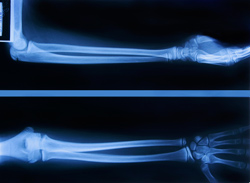Radiography

A survey released last year reported that there is a shortage of radiographers in Ireland, despite an increase in training and education options.
Radiography was born in 1895 with the discovery of X-rays; to this day this is the principle concern of the radiographer along with working with other forms of radiation in medical imaging and treatment. Radiographers tend to fall into one of two sectors; Diagnostic and therapeutic radiographers. Those who take images of the human body to assist with medical diagnoses (e.g. identifying broken bones) are known as diagnostic radiographers and those who use radiation to treat medical conditions (e.g. attacking cancerous cells) are therapeutic radiographers.
Radiography calls for what could be considered as conflicting talents, in that you need to be caring and approachable while remaining technologically and scientifically astute.
Education
There are two radiography options in the CAO system – the Radiography honours degree at UCD, and the Radiation Therapy honours degree at TCD. As with the majority of healthcare courses, the required CAO points are high – typically between 500 and 540. Candidates are required to take at least one honours level science subject in their Leaving Cert.
Both degree courses mix theoretical and clinical elements to provide a rounded education in Radiography. Students take classes in basic science subjects such as Physics, Chemistry and Mathematics, as well as other subjects like Human Anatomy, Physiology, and Biochemistry.
Radiography students’ specialist subjects include Ultrasound and Advanced Physics, while Radiation Therapy students take options such as Cancer & its Overall Management and Counselling & Communication.
A large proportion of the final two years is spent in clinical practice, usually in a hospital, and by the end of the course students will be working with actual patients in a professional setting.
Students with an interest in Radiography might also consider similar subjects such as Physiotherapy, Physics, and Medicine.
Options After Qualification
Radiography graduates can apply for membership with the Irish Institute of Radiography (IIR), which allows them to work as radiographers in Ireland and to gain recognition of their qualification worldwide.
The majority of radiographers and radiation therapists are employed by the health service, in both public and private hospitals. Graduates can also work in research and development, medical industries, and in a variety of other science-based careers.
There are many postgraduate opportunities for radiography graduates, and some people decide to pursue further research in areas such as Ultrasound Scanning, Magnetic Resonance Imaging, or Mammography.
Radiography is a constantly developing field, and the IIR runs regular career development courses to ensure that professional radiographers know all the latest technologies and practices.
The Work
Radiography as a career can be divided up into two distinct roles, although there can be some crossover in practice. Diagnostic radiographers are required to produce high quality images to assist in the diagnosis and treatment of disease while therapeutic radiographers, also known as radiation therapists administer courses of radiation therapy.
Diagnostic radiographers are principally involved in taking X-ray images of parts of a patient’s body where there is a possible illness or injury. For instance, if somebody has a broken leg, the radiographer uses complex X-ray equipment to produce an image that shows the precise location of the injury, and how badly the bone is damaged.
Ultrasound equipment is used to take images of soft tissue and is used for monitoring babies in the womb. Radiographers make sure that the patient is exposed to a minimum amount of radiation while still producing a good quality image.
Radiation therapists typically work with cancer patients and are involved in all aspects of the treatment process. Working alongside other medical staff, they decide on the correct treatment, assessing the size and location of the tumour with computer-controlled equipment such as CT scanners.
The information gathered is then used to calculate the optimum dose of radiation needed and what equipment is to be used. (X-rays, gamma rays, and electrons are all used to treat malignant disease, and each type of ray is produced by different equipment.)
As well as providing clinical care, radiation therapists must also establish a good relationship with each patient they are treating, offering them reassurance and encouragement, as the process can be quite painful and distressing for patients.
Personal Qualities & Work Environment
A high level of organisation and communication is expected for success in this area. An aptitude with science and a compassionate personality are also important qualities.
Radiographers usually work in a hospital, laboratory, or clinical environment.
The Money
Radiographers in the health service start out on approximately €32,000 a year, which can rise with experience and further training to well over €50,000.
The Jargon
Radiation: A stream of particles or electromagnetic waves emitted by the atoms and molecules of a radioactive substance
Ultrasound: High-frequency sound waves
Tumour: An abnormal mass of tissue possessing no physiological function, which may be malignant or benign
Job Titles
Radiographer
Diagnostic Radiographer
Radiation Therapist
